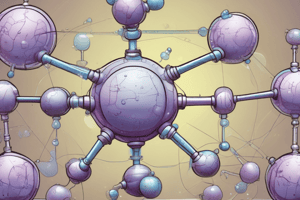Podcast
Questions and Answers
What is a nucleophile?
What is a nucleophile?
- Electron poor with a positive charge
- Electron rich with a negative charge (correct)
- A highly reactive compound with free electrons
- An intermediate state in a reaction
What is the main difference between heterolytic and homolytic cleavage?
What is the main difference between heterolytic and homolytic cleavage?
- Heterolytic cleavage is faster, while homolytic cleavage is slower
- Heterolytic cleavage forms two free radicals, while homolytic cleavage forms a carbocation and a hydride ion
- Heterolytic cleavage forms a carbocation and a hydride ion, while homolytic cleavage forms two free radicals (correct)
- Heterolytic cleavage forms a carbanion, while homolytic cleavage forms a carbocation
What is the mnemonic device for remembering oxidation and reduction reactions?
What is the mnemonic device for remembering oxidation and reduction reactions?
- RIG OIL
- GRIL OI
- ROLIG
- OIL RIG (correct)
What is biological oxidation?
What is biological oxidation?
What is the role of the protein in chemical catalysis?
What is the role of the protein in chemical catalysis?
What is the transition state in a reaction?
What is the transition state in a reaction?
What type of amino acids are typically found at the active site of an enzyme?
What type of amino acids are typically found at the active site of an enzyme?
What is the primary function of histidine in acid-base catalysis?
What is the primary function of histidine in acid-base catalysis?
In covalent catalysis, what is the role of the enzyme (E) in the reaction?
In covalent catalysis, what is the role of the enzyme (E) in the reaction?
What is the difference between acid-base catalysis and base catalysis?
What is the difference between acid-base catalysis and base catalysis?
What is the purpose of the proton in acid-base catalysis?
What is the purpose of the proton in acid-base catalysis?
What is the role of the substrate in covalent catalysis?
What is the role of the substrate in covalent catalysis?
Flashcards are hidden until you start studying
Study Notes
Nucleophilic Substitution
- A nucleophile is electron-rich, negatively charged, and seeks electrons.
- An electrophile is electron-poor, positively charged, and seeks electrons.
- High electronegativity leads to a more stable intermediate state, but not stable enough, as electrons are shared between carbon and oxygen.
- To restabilize, electrons on oxygen move between oxygen and carbon, breaking one bond and re-establishing a double bond, and forming a leaving group.
Cleavage Reactions
- Heterolytic cleavage forms a carbanion and a hydride ion, carrying the shared electrons.
- Homolytic cleavage breaks a bond, each compound taking one electron, forming highly reactive free radicals.
Oxidation-Reduction Reactions
- Oxidation involves electron transfer, resulting in the oxidized compound losing electrons.
- Reduction involves electron gain, resulting in the reduced compound gaining electrons.
- OIL RIG: Oxidation Is Loss, Reduction Is Gain.
Biological Oxidation
- Addition of oxygen, removal of electrons, or dehydrogenation (removing hydrogen, resulting in hydride ions).
Chemical Catalysis
- Enzyme: a protein that aids chemical reactions.
- Substrate: the molecule on which the enzyme acts.
- Active site: the enzyme's binding site, containing hydrophobic amino acids and polar amino acids facilitating acid-base or covalent catalysis.
Types of Catalysis
- Acid-base catalysis: donation or gain of protons, increasing the reaction rate through catalytic proton transfer.
- Covalent catalysis: covalent bond formation between the substrate and enzyme.
Acid-Base Catalysis
- Histidine's imidazole group, with a pKa close to the solution's pH, donates/accepts protons, facilitating the reaction.
- Base catalysis removes protons, indirectly participating in bond cleavage.
- Acid catalysis involves proton donation.
Covalent Catalysis
- Substrate binds covalently to the enzyme (E), enabling covalent catalysis.
- Example: Sucrose phosphorylase facilitates the reaction sucrose + Pi → glucose-1-P + fructose.
Studying That Suits You
Use AI to generate personalized quizzes and flashcards to suit your learning preferences.




